| Article ID | Journal | Published Year | Pages | File Type |
|---|---|---|---|---|
| 4733091 | Journal of Structural Geology | 2014 | 15 Pages |
•Fluid inclusion plane studies indicate exhumation of a Permian granite intrusion.•The exhumation was unusual in the extensional stress regime during the Triassic.•Regional fluid flow accompanied the exhumation of the granite intrusion.•Exhumation of the different blocks of the granite intrusion was inhomogeneous.•Structural analyzes indicate block rotation between the blocks of the intrusion.
A new approach, the fluid inclusion plane technique coupled with fluid inclusion microthermometry and field measurements have been applied to demonstrate the exhumation and relative vertical displacements of an allochthonous, Permian granite intrusion (Velence Mts.) which was situated in the Middle Triassic at the western end of the Neotethys rift system. The pressure and the temperature conditions during the Permian fluid flow (>350 °C and ∼2 kbar) in the granite were considerably higher than during the Triassic fluid flow (<250 °C and ∼0.5 kbar), which indicates the exhumation of the granite intrusion in a primarily extensional tectonic stress regime. The fluid inclusion planes with NE–SW and NW–SE strike prove stress field permutation that can be explained by the exhumation of the host granite during the Middle Triassic fluid flow.It is suggested that the exhumation of the Velence Mts. along with the regional fluid flow can be connected to the passive pre-rift phase of the northern Adriatic Block, during the Middle–Late Triassic. The variations in homogenization temperatures of Triassic regional fluid inclusion assemblages between the blocks of the granite, as well as variations in the fluid inclusion plane orientations, suggest a post-Triassic vertical segmentation and relative block rotation of the granite.
